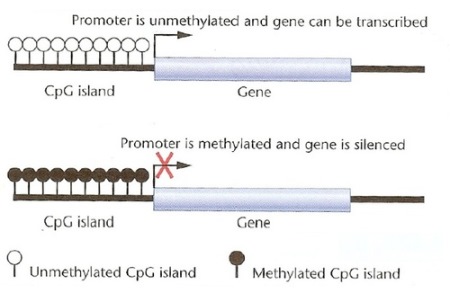Change of the Global Methylation Pattern to Alter the Growth Phenotype of CHO-Cells
SUPERVISOR: NICOLE BORTH
Background.
Today recombinant therapeutic proteins are mainly produced in mammalian cell lines due to their advantages of correct protein folding, post-translational modifications and product assembly (Khan 2013). Over 70% of all recombinant proteins are produced in Chinese Hamster Ovary (CHO) cells (Kim et al. 2012), consequently there is a huge interest in improving this major expression system. Feichtinger et al. 2016 showed that epigenetic regulation plays a major role in CHO cells for activation and deactivation of genes. In general cells are able to regulate the expression of genes without altering the genomic sequence. This overlaying DNA regulation is known as "Epigenetics". The two major components of epigenetics are DNA methylation on the C5 atom of cytidine and histone modifications (Kwaks and Otte 2006). Mammalians (in contrast to other organism) possess a hypermethylated genome, where only small GC rich regions in the promotor region are hypomethylated. These so called "CpG Islands" determine whether a gene is active or not (Figure 1). A methylated island is associated with a turned off gene and, in contrast, demethylation with gene activation (Illingworth and Bird 2009). Histone modifications on the other hand are much more complex, as different histones may bear different modifications (acetylation, methylation, ubiquitinylation and many more)(Mai and Altucci 2009; Marmorstein and Trievel 2009).

Feichtinger et al. were able to show that CHO cells tend to change their histone modifications to adapt to short term culture changes (e.g.: during a batch culture). If the changes are maintained for a longer period (e.g. upon adaptation to different culture conditions), cells alter their DNA methylation pattern to activate or deactivate the necessary genes. The hypothesis for the current project therefore proposes that with artificial alteration of the epigenome and thus gene expression, it should be possible to generate cells with improved growth behaviour.
Aims and methods.
TThe aim of this project is to randomly alter the epigenome to increase the growth rate of CHO cells. To do so, three aspects are investigated:
• Identification and characterisation of substances which are able to alter the DNA methylation pattern of cells
• Use of these substances to increase the growth rate of cells
• To characterise the isolated cells with respect to DNA methylation patterns, transcriptome and growth behaviour
Feichtinger, J. et al., 2016. Comprehensive genome and epigenome characterization of CHO cells in response to evolutionary pressures and over time. Biotechnology and Bioengineering, 9999(xxx), pp.1–13.
Illingworth, R.S.and Bird, A.P., 2009. CpG islands - A rough guide. FEBS Letters, 583(11), pp.1713–1720.
Khan, K.H., 2013. Gene expression in mammalian cells and its applications. Advanced Pharmaceutical Bulletin, 3(2), pp.257–263.
Kim, J.Y., Kim, Y.G., Lee, G.M., 2012. CHO cells in biotechnology for production of recombinant proteins: Current state and further potential. Applied Microbiology and Biotechnology, 93(3), pp.917–930.
Kwaks, T.H.J., Otte, A.P., 2006. Employing epigenetics to augment the expression of therapeutic proteins in mammalian cells. Trends in Biotechnology, 24(3), pp.137–142.
Mai, A., Altucci, L., 2009. Epi-drugs to fight cancer: From chemistry to cancer treatment, the road ahead. International Journal of Biochemistry and Cell Biology, 41(1), pp.199–213.
